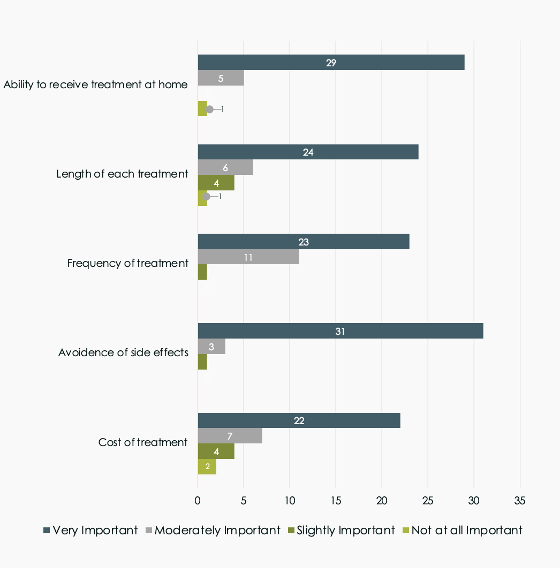The Unrealized Power of Digital Therapeutics
Exploring the top 3 reasons that digital therapeutics are desired and the top 3 barriers to access
We live in an era of fast-paced innovation to help optimize patient outcomes and change the way that people live and manage their diseases. One of the most accessible new developments is digital therapeutics (DTx), defined as health software intended to treat or alleviate a disease, disorder, condition, or injury by generating and delivering a medical intervention that has a demonstrable positive therapeutic impact on a patient’s health. DTx can provide additional and often more manageable options for treating and managing chronic and acute diseases. A recent study in collaboration with the Digital Therapeutics Alliance revealed that, although interest in trying a DTx is high, there is an underlying lack of education about digital therapeutics, and uptake lags behind the science.
| Examples of Digital Therapeutics | NOT Digital Therapeutics |
|---|---|
| Smartphone program that provides physical or mental health therapy | WebMD |
| Virtual Reality headset for pain management | Telehealth or Teletherapy |
| Video game for ADHD treatment | Web or app patient portal such as MyChart |
| Smart inhaler platform for asthma or COPD | Glucose monitor |
Specific requirements for digital therapeutics:
| Digital Therapeutics | Tools that are NOT Digital Therapeutics |
|---|---|
| Tested and proven through effective clinical trials | May or may not have been researched or tested through clinical trials |
| Prescribed or recommended by a clinician, typically | Can be downloaded or used without a prescription or reccomendation |
| Often regulated by the FDA like other treatments such as medications or medical devices (e.g., pacemakers, insulin pumps | Not regulated by the FDA |
| Used to treat a condition, similar to medications or medical devices | Used to track symptoms or provide education |
Digital therapeutics must meet a specific set of requirements that other digital health tools do not. But FDA approval doesn’t necessarily overcome challenges with uptake—insurers have also been slow to accept these novel treatments, despite their proven benefit, creating additional barriers for companies to successfully capitalize on the significant potential of DTx.
Research on interest and uptake of DTx conducted by Rx4good in collaboration with the Digital Therapeutics Alliance (DTA), found that ninety-one percent of patient and caregiver respondents reported that they would be somewhat or extremely likely to try a DTx to help manage or treat a health condition.
High levels of interest in trying or learning more about DTx may be attributable to how well they deliver on the most desirable features of a treatment. Survey respondents cited “ability to receive treatment at home” and “avoiding side effects” as the most desired attributes of a treatment. Digital therapeutics may reduce travel to hospitals or clinics to receive treatment because they are often administered at home via software, and lack undesired and uncomfortable side effects that can occur with treatments administered into the body.

Interest in digital therapeutics is reported as high in this preliminary analysis, and DTx fulfill many of the features patients look for in treatment. However, uptake is low, as is both awareness and education about DTx.
These results revealed that increasing education among patients and providers around the possible benefits of digital therapeutics, how they work, and their role in care is a necessary first step to improving uptake and informed decision-making.
Reflecting on the results, Lani Hessen, VP of Patient Access for DTA, points out that the findings highlight several opportunities for companies in the digital health space:
- Tailor educational materials to patient treatment pain points and needs
- Increase access to information about DTx for health care professionals and consumers
- Highlight the features of digital therapeutics that appeal most to patients and caregivers
- Use the channels for education and awareness that people look to and trust the most, such as healthcare providers and advocacy organizations
“I want to do what is in my power to better track, manage, and treat my health conditions, such as asthma. The idea of digital therapeutics makes me think it could help me achieve that goal and feel more hopeful and at peace. It could help improve my life in a way that works better for me and is more effective than what I am currently doing.”
The power of digital therapeutics is right in front of us, with the potential to offer tremendous benefits to patient care and outcomes. With a little attention and focus, HCPs, patients, and other stakeholders can work together to make digital therapeutics easier to understand, access and use to optimize patient care.
The Digital Therapeutics Alliance, an international non-profit trade association of industry leaders and stakeholders, defines digital therapeutics (DTx) as digital health technologies (DHTs) that are clinically proven (i.e., evidence-based therapeutic interventions) to treat, manage and prevent diseases and disorders with software-based technologies.
The preliminary research findings were presented at the Inaugural Digital Therapeutics Alliance Summit in Washington, DC, in June. These findings were based on 87 survey respondents including patients and care partners of patients living with a wide variety of diagnoses, ranging in age from under 18 years old to over 70 years old.
